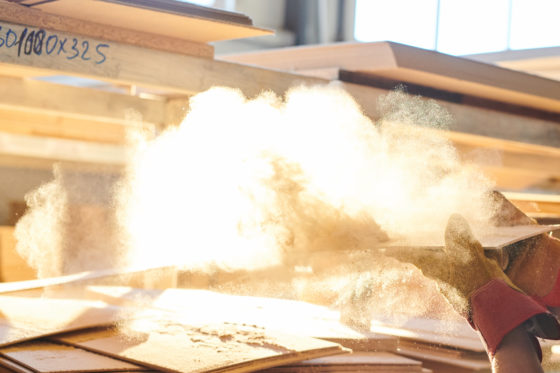Dust from wood, metal, flour, and more can ignite. Free online training can help employers, contractors, and workers in manufacturing control the hazard.

Photo credit: iStock.com/SeventyFour
Just about any substance can be combustible when it’s the size of a grain of table salt.
“When we grind things up very small, almost everything burns,” says Lorne Davies, safety advisor and combustible dust specialist with the Manufacturing Safety Alliance of BC (MSABC).
“All organic material — from cocoa to flour to wood — is flammable and combustible. In addition, metals and plastics can also be flammable at this particle size. If you generate a cloud of these products, and you have the appropriate air-fuel mixture, they ignite really well.”
In his role, Lorne visits employers who ask for advice on combustible dust issues. He works with all kinds of employers, including machine shops, food processors, wineries, breweries, and manufacturers of plastic and foam.
A good first step for any manufacturing employer looking to learn more about combustible dust is Combustible Dust Awareness, a free online course from MSABC. It takes about three hours to complete, and there are also versions specifically for workers and for contractors.
Lorne says employers can use the course to answer important questions such as:
- Is the type of dust in our workplace a hazard?
- How can we determine if our dust is combustible?
- How flammable is it?
- Is present housekeeping adequate to control the hazard?
- Can we use air hoses to clean combustible dust safely?
- Is our dust collection system designed to control the explosion of combustible dust and vent it safely away from the building and employees?
Controlling combustible dust before it accumulates
The more dust that accumulates, the greater the hazard. Dust often accumulates on hard-to-see places like trusses and horizontal beams of ceilings.
Says Lorne: “No one really sees the dust because it’s way up there. You can walk through the plant, see the floors are clean, and think everything looks good.”
All it takes is for one event to disturb the dust, which causes it to fall and create a dust cloud that can ignite and lead to a serious fire. An ignited dust cloud generates a wave of pressure that moves through the building, igniting additional dust along the way. The most common sources of ignition are welding, cutting, or other open flames. Static electricity can also be an ignition source — and the risk of this is higher in dry air (when relative humidity is below 40 percent).
In 2012, combustible dust accumulation caused explosions at sawmills in Burns Lake and Prince George. Sadly, four workers died and another 44 were injured.
Thanks to Lorne for talking with me about his efforts to raise awareness of combustible dust hazards. See WorkSafeBC’s webpage on Combustible dust for more resources and to find information on combustible dust training and education.


